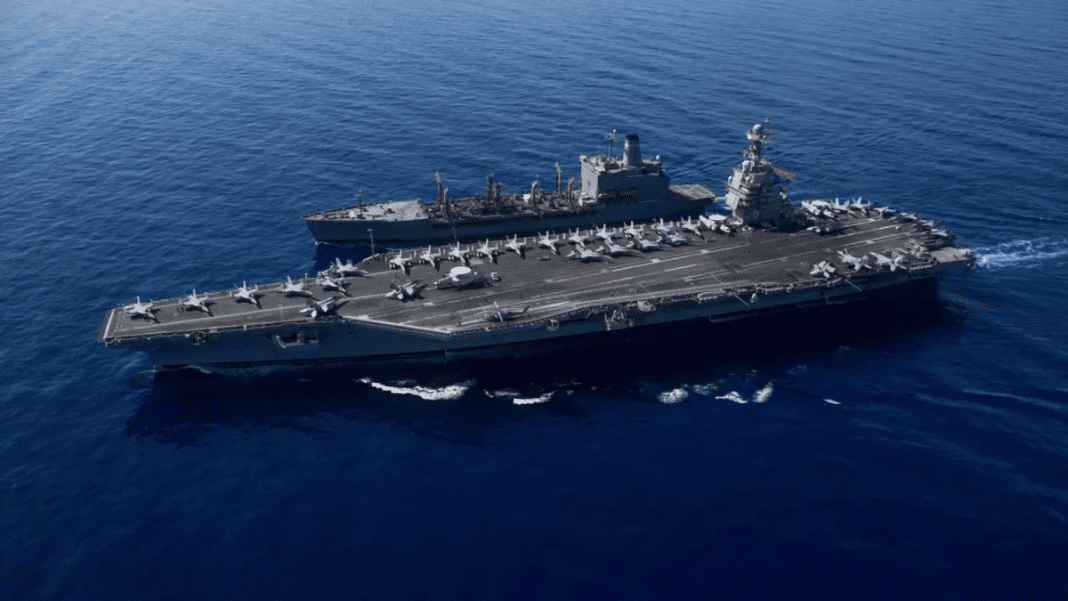The world’s largest aircraft carrier, the USS Gerald R Ford, has entered Latin American waters under the command of the United States Southern Command (SOUTHCOM). This move marks one of the biggest American military deployments in the Caribbean region in decades. The arrival of the massive ship, supported by destroyers, fighter jets, and a nuclear-powered submarine, comes amid growing tensions between the United States and Venezuela.
USS Gerald R Ford Shows US Strength in the Caribbean
The Pentagon explained that the deployment of the USS Gerald R Ford is part of an effort to strengthen its presence in Latin America and the Caribbean, saying it aims to stop the flow of illegal drugs. Moreover, the United States has long accused traffickers of using these waters to smuggle narcotics into North America.
The USS Gerald R Ford, however, is not just another ship. In fact, it is the largest and most advanced aircraft carrier ever built, carrying dozens of warplanes, helicopters, and thousands of sailors. Its presence alone, therefore, sends a powerful message about America’s strength at sea. Additionally, the strike group traveling with the USS Gerald R Ford includes guided-missile destroyers and supply ships, forming a formidable force capable of operating independently for months.
Pentagon officials have said that the USS Gerald R Ford’s deployment will help monitor, detect, and disrupt illicit activities in the region. They described the mission as part of a larger “war on drugs” campaign, focused on tracking and intercepting smuggling operations in Caribbean and Pacific waters. Since this campaign intensified earlier this year, airstrikes on suspected smuggling boats have reportedly killed dozens of people in South American waters.
Venezuela Mobilizes Forces in Response to USS Gerald R Ford
In direct response to the arrival of the USS Gerald R Ford, Venezuela has ordered a massive military mobilization across the country. The government has placed its army, navy, air force, and even river patrol units on high alert. Civilian militias have also joined the defensive effort, showing that the country sees this as a serious threat to its security.
Officials in Caracas accuse the United States of provoking instability under the cover of fighting drug trafficking. Local leaders describe the arrival of the USS Gerald R Ford near Venezuelan waters as a provocative show of force that endangers peace in the region.
The Venezuelan defense ministry has confirmed that alert levels are now at their highest, and military units are preparing for guerrilla-style resistance if a conflict begins. Plans include using small groups to carry out sabotage and defensive operations. While much of Venezuela’s military equipment is older Russian-made technology, the government insists that its forces remain capable of defending their territory.
EU targets Russian ‘shadow fleet’ in new sanctions over fake Caribbean ship flags
Reports from local media suggest that anti-aircraft and coastal defense systems have been repositioned near key areas. The government has also ordered regular training exercises for its air defense units. Officials have stated that the country will not tolerate what they see as foreign aggression, linking the USS Gerald R Ford’s mission to a potential US attempt to pressure their government.
The strong military reaction from Venezuela reflects the deep mistrust and long history of tension between the two countries. The presence of the USS Gerald R Ford strike group so close to Venezuela’s coast has only made these tensions more visible.
Latin American Leaders Urge Calm and Political Dialogue
As the situation intensifies, leaders from across Latin America and the Caribbean are calling for calm and restraint. During the Community of Latin American and Caribbean States (CELAC) summit in Colombia, representatives from 58 out of 60 nations issued a joint statement rejecting the use or threat of military force. They emphasized that disputes in the region must be resolved through diplomacy and respect for international law.
The statement reaffirmed that Latin America and the Caribbean are a “zone of peace.” Several leaders expressed concern that the deployment of the USS Gerald R Ford could destabilize the region if communication breaks down between Washington and Caracas.
Neighboring countries have urged both sides to maintain dialogue and avoid any steps that could lead to military confrontation. Some leaders warned that any clash involving the USS Gerald R Ford would have serious consequences for trade, security, and regional cooperation.
In recent years, relations between the United States and Venezuela have already been strained due to economic sanctions, political disputes, and diplomatic expulsions. Now, with the USS Gerald R Ford leading a powerful naval strike group near Venezuela’s coastline, many fear that a single misstep could escalate into a wider conflict.
For people across the region, the sight of the USS Gerald R Ford patrolling Latin American waters is both a sign of strength and a source of worry. It underscores the growing military tension between the two nations and raises questions about how far each side is willing to go in this standoff.

